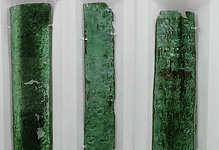
The Qumran Community
In 1947 two Beduin shepherds accidentally came accross a clay jar in a cave near Khirbet Qumran, that contained seven parchment scrolls. The Scrolls came into the hands of dealers who offered them to scholars. The first scholar to recognise their antiquity was E.L. Sukenik who succeeded in acquiring three of them for the Hebrew University. The other scrolls were smuggled to the United States where three of them were published in 1950 - 1951. Later they were offered for sale and Yigael Yadin, the son of Professor Sukenik, succeeded in buying them and bringing them back to Israel. The Israel Museum in Jerusalem constructed a special site for exhibiting the scrolls, the "Shrine of the Book".
The Community to which the Dead Sea Scrolls belonged occupied Qumran around 130 BCE to 70 CE. It was an extremist offshoot of the Jewish apocalyptic movement whose basic doctrine was the expectation of the end of days, soon to come. A "Teacher of Righteousness" was their spiritual and social leader. The sect followed its own interpretation of traditional Judaism, it stated that a calendar of 364 days had to be adopted.
Some scholars believe that both John the Baptist and Jesus spent time in Qumran.

#08021464
Jar which contained some of the Dead Sea-scrolls. From Qumran,Israel....

#08030327
The caves of the scrolls seen from the settlement of Qumran, Israel

#08030328
The caves of the scrolls, seen from Qumran, Israel

#08030329
Water reservoir - settlement of Qumran, Israel

#08030330
Meeting room, Qumran, Israel

#08030331
Stairs leading into a water resevoir Qumran, Israel

#08040333
Qumran, Israel, on the coast of the Dead Sea, a first monastic settlement of t...

#08040334
Entrance gate to a first monastic settlement of the Essene Sect in Qumran, I...

#08040335
A ritual bath of a first monastic settlement of the Essene Sect in Qumran, d...

#08040336
Qumran on the shores of the Dead Sea, Israel. A water duct in the monastic set...

#08040619
The caves of Qumran,where the Dead Sea Scrolls were found in 1947.Qumran was...

#08040620
Qumran was the center of the Essenes,a break-away sect from Judaism,who chose...